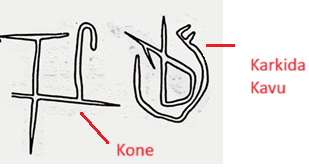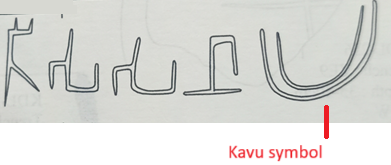Evidence of composite writing of the Indus script and Tamili script in Kodumanal, Tamil Nadu.
Evidence of composite writing of the Indus script and Tamili script in Kodumanal, Tamil Nadu.
The inscription nearby is from Kodumanal, near Tirupur, Tamil Nadu. This inscription demonstrates the composite writing of the Tamili script and the Indus script. Reference page number 412 of the book by Rajan. It is a broken pottery piece; hence, the full name of the person is not available; only the last part of the name is available, which indicates that the name ends with “Kone”. The author of the book, Rajan, has not fully deciphered all the inscriptions; he left out the last symbol, marked with a #, indicating that the meaning is unknown (or unreadable). (1)
The problem mentioned above arises because the last symbol is from the Indus script. The Tamil Nadu funeral priest had written in a composite language, using both Tamil script and Indus script. It is no longer a problem; this Indus symbol can be read. This symbol reads as “Karkida -Kavu”, which refers to a sacrifice performed on the eve of the Karkida month ritual. This inscription provides further evidence to support my theory that the Indus scripts were used for funeral rituals. The above inscription confirms my earlier observations. The surprising fact is that the Indus scripts were in use in Tamil Nadu till the arrival of Tamil Brahmi scripts in the Sangam age.
The above inscription shows another evidence of composite writing. The name of the dead person was “Periyan Sadan” as per the decipherment of Rajan. The only deficiency is that Rajan does not interpret the last symbol, as it is an Indus Symbol. The last symbol , the cone with the “Heaven plate” symbol, indicates the attainment of heaven by the dead man. Thus, it is a composite writing by a Tamil Nadu funeral priest.
Figure 3Picture courtesy Rajan. (1)
Another pot fragment shows the name “Tissan”. Reference page no 344 of the book by Prof Rajan. Prof. Rajan has interpreted the first four letters as “Tissan” and left the last symbol without interpretation, because it is not a Brahmi script, but an Indus script symbol. The above example shows another example of composite writing by Tamil Nadu funeral priests. The last symbol indicates the pot in which sacrificial blood was offered to the dead person. This pot symbolises the word “Kavu” (sacrifice).
Figure 4Picture courtesy Rajan. (1)
The above-mentioned pot graffiti is another example of mixed language writing. Picture reference page no. 224 from the book of K.Rajan. (1) He had interpreted all the Tamil Brahmi letters in this inscription, except for the last symbol, because it is written in the Indus script. Now, it is time to read the last remaining puzzle. The last symbol is an ideogram saying that “Karkida -Kavu”. Now, the meaning of the sentence is clear that the Karkida Kavu sacrifice was carried out to either please the god or the dead Pithru himself.
References
1. Rajan., K. Thonmai Tamizh Iyal (in Tamil). Chennai : International Institute of Tamil Studies., 2018.




